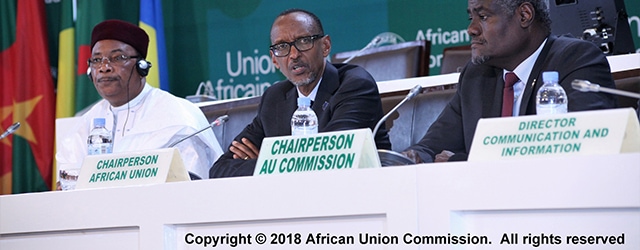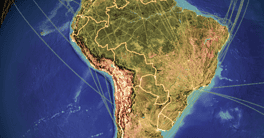A new tariff-reduction deal aims to knit Africa together economically. But with infrastructure and productivity deficits, is the continent ready to take advantage of it?

Officials at an AfCFTA press conference. |
A new and globally significant trade bloc is in the making. The African Continental Free Trade Area (AfCFTA) will embrace more than 1.2 billion people, generating a combined GDP of more than $3 trillion—provided all 55 African nations sign up for it and commit to removing tariffs on 90% of goods traded within the continent.
Addressing tariffs is just the first stage, with further negotiations on dismantling other barriers, such as long border delays, and accelerating harmonization of standards across the continent. Among the key issues still to be agreed upon are regulatory frameworks to facilitate market access and investment, competition and dispute-resolution mechanisms and intellectual-property rights. Likewise, more countries need to sign on to the protocol for the free movement of people.
“The potential is huge,” says David Luke, coordinator of the African Trade Policy Centre at the Addis Ababa–based UN Economic Commission for Africa (UNECA), which estimates that implementation of the deal on tariffs could boost intra-African trade by 52% within four years. If this is followed by the removal of non-tariff barriers, it would lead to a doubling of trade within the continent, according to UNECA.
In sub-Saharan Africa, regional trade has already grown significantly, according to a recent International Monetary Fund report, from 6% of total exports in 1980 to nearly 20% today—although that is still much lower than regional trade volumes in Asia or Latin America. The IMF also notes that the bulk of this trade occurs within subregions, with the five countries that make up the Southern African Development Community (SADC) accounting for half of all trade between sub-Saharan states.
“The realization has hit that the continent needs to scale up from regional economic communities like SADC and ECOWAS [Economic Community of West African States], so that Africa as a whole is more attractive to investors,” says Luke. The comparatively small size of most African economies and their regional fragmentation has, until recently, been a brake on inward investment. Even the biggest economies, such as South Africa and Nigeria, are only 2% to 3% the size of the European Union or the US, Luke notes.
The process of knitting the continent together has already begun. Initially, the heads of 44 African countries committed to AfCFTA at a summit in Kigali, Rwanda, last March. Since then, South Africa and four other countries have signed up, bringing the total to 49.
There is strong momentum to push the deal through in time for the next African Union Summit, to be held in Addis Ababa in January. A new bureau chaired by Uganda is charged with implementing the deal, along with negotiating future trade relations with third parties, ahead of a meeting of African trade ministers in Cairo at the end of this year. “But it’s not going to be straightforward,” cautions Luke, noting that a small minority of states still haven’t signed on to the initiative.
The most significant of these is Nigeria, which chaired the final negotiating rounds leading to the agreement on AfCFTA, but now wants time to consult with its business community and labor unions. “Nigeria is a special case,” says Luke. “With President Buhari facing elections next year, internal politics need to play out.” Still, Nigeria’s strong industrial base and role as a regional hub would make it one of the main beneficiaries of a free-trade area, and the country is expected to join in due course.
For the trade bloc to become a reality, the agreement needs to be ratified by 22 countries, all of which need to deliver legislative approval. So far, seven countries have completed ratification, and several others, including South Africa, are in the process. While it isn’t yet a done deal, Luke says, “the prospects of 22 countries ratifying by early 2019 are good.”
The new trade bloc is expected to develop through stages, starting with a tariff-free zone for physical goods to covering non-tariff barriers and services to greater harmonization of standards. A second round of negotiations will cover investment, intellectual property, and competition policy. Luke sees the end result as “a hybrid between a free-trade area and a single market.”
Larger countries, such as Egypt, Nigeria and South Africa, which have well-established industrial bases and financial markets, are likely to be the early winners, as are international businesses that already have a pan-African footprint.
“We see a lot of potential in the AfCFTA,” says Gloria Nwabuike, head of corporate communication and public affairs for Nestlé Nigeria. “It will make it easier for us to get the documentation, all the approvals that we need for us to export [and help ease the] delays and bottlenecks that, looking at the shelf-life of products, are a struggle for us a lot of the time.”
“Clearly, things are moving in the right direction,” says Maximiliano Mendez-Parra, senior research fellow at the London-based Overseas Development Institute. “But while it may seem like a magical solution, establishing a free-trade area is not enough in itself.”
Inadequate transportation infrastructure and lack of productive capacity in some countries highlight the need for huge investment—from governments, multilateral organizations and the private sector—not only in new infrastructure but also on the “soft side,” ensuring that it is effectively managed. “Only when these issues are addressed will businesses be able to make long-term decisions about supplying their product across the continent,” says Mendez-Parra.
The initial dislocations to smaller economies from sudden removal of tariffs are another key concern. Government revenues will be hit; and although, on average, tariffs contribute only 15% of all taxes in African countries, in some they form a vital component of the national budget. Likewise, some could see a short-term deterioration in their balance of trade.
Luke claims that the long-term benefits of AfCFTA far outweigh these issues. “We now live in an era where final goods are not made in any one place but are at the end of an international value chain,” he says. “African countries need to focus on their comparative advantage, where they can generate value-added, and then see how to position themselves best within both the African and global economy.” That’s not necessarily the route the new trade bloc will take.
“One concern about the agreement,” says Mendez-Parra, “is that it could create a protectionist bloc, closing the African continent to the rest of the world. There is always a risk of trade diversion, of replacing efficient external suppliers with inefficient ones from within Africa.”
Another concern is that, after only a minimum of value is added in AfCFTA-signatory nations, cheap imports from outside Africa will leverage the deal to gain tariff-free access to the entire continent, wiping out any advantages to be gained from inward investment. But those pushing for the deal argue that growth in trade, plus the new investment this will trigger, far outweigh such dangers.
Unlike previous IMF and World Bank reforms imposed from the outside, AfCFTA has been developed by African bodies, governments and stakeholders. Luke points out, “These trade reforms are homegrown.” For better or worse, Africans are making their own future.



